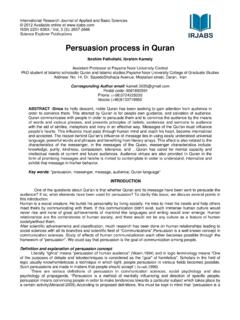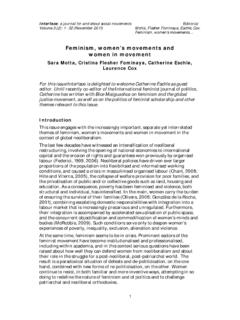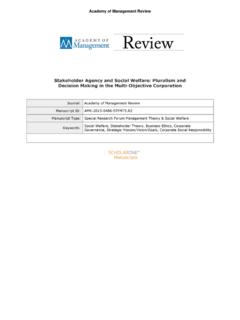Transcription of Marginalization and Oppression of Afro-American …
1 International Research Journal of Applied and Basic Sciences 2013 Available online at ISSN 2251-838X / Vol, 4 (4): 915-920. Science Explorer Publications Marginalization and Oppression of Afro-American Women in Toni Morrison's Sula Nasrin Chegeni1, Nastaran Chegeni2. 1. Islamic Azad University, Boroujerd Branch, Iran 2. Islamic Azad University, Shahreza Branch, Iran Corresponding author email: ABSTRACT: Within the Modern Feminist Movement, white women have been accused of focusing on Oppression in terms of gender while ignoring issues of racism, and sexism.
2 Unlike white women, black women suffered from multiple oppressions by being black and woman at the same time. In resistance to this Marginalization , the theory of black feminism was forged. This theoretical concept was developed to call attention to the multiple oppressions experienced by black women, reflecting and defining their everyday experiences in their own terms. This paper is concerned with the depiction of black women's Marginalization and Oppression in Sula by Toni Morrison. It examines the quality of black women's suffering through racism, and sexism in the American society.
3 Sula is studied as the basis for this analysis, because it depicts the Oppression towards the black people in different forms, especially on women's marginalized life. Key words: Afro-American Women; Oppression ; Racism; Sexism; Marginalization Overview The African American novelist, Toni Morrison is a writer deeply concerned with issues such as race, gender and sexuality. She is one of the most prominent writers of fiction in contemporary America. Although the impact of white racism on black communities is undeniable, Morrison addresses the question of the position of women within black communities, and how their relationships with both men and other women shape their lives.
4 Morrison began writing Sula in 1969, a time of great activism among African Americans and others who were working toward equal civil rights and opportunities. The novel addresses issues of racism, and suppression of African Americans. It depicts the disappointed people fell when they cannot get decent jobs and the determination of some to survive. The events of the book open in 1919, when African-American soldiers returned home from Europe after World War I and they did not receive as much respect for their service as their white soldiers.
5 When they returned, many began working for civil rights, reasoning that if they were considered good enough to fight and risk their lives for their country, they should be given full participation in society. In 1929, the stock market crashed, leading to widespread depression and deep poverty. Skilled and unskilled, African-American and white, few people escaped the suffering involved. Through laws known as Jim Crow laws, Southern states were forcefully segregated, with separate facilities for travel, eating, drinking, school, church, housing and other services for African Americans and Whites.
6 These facilities were separated and many times not equal, those for African Americans were frequently nonexistent. If an African American failed to obey the segregation laws, he or she is arrested and imprisoned. The civil rights movement grew with protests, nonviolent resistance, boycotts and rallies which received increasing attention in the national media. In addition, activist challenged the segregation laws in court and in other areas of life such as on buses and in schools, although racist incidents continued to cause trouble for African American.
7 Review of the related literature Critics have expressed different views from many perspectives on Sula. Bergenholtz's (1996, cited in Bloom, 1999) Toni Morrison's Sula: A Satire on Binary Thinking sees Sula as Toni Morrison's satire on clich d thinking. In In Search of Self: Frustration and Denial in Toni Morrison's Sula, Nigro (1998, cited in Bloom, 1999) examines the characters who live in Medallion, Ohio and celebrated the lives of ordinary people who daily must work. Intl. Res. J. Appl. Basic. Sci.
8 Vol., 4 (4), 915-920, 2013. Christian (1980, cited in Bloom, 1999) in The Contemporary Fables of Toni Morrison reads Sula as a paradoxical fable, at once a critique of the community's failure to live, and yet a celebration of survival. Spillers (1983, cited in Bloom, 1999) in his article A Hateful Passion, a Lost Love traces the changes in black female characterization in transition from Zora Neale Huston and Margaret Walker to Toni Morrison. Dematakopoulos'. (1987, cited in Bloom, 1999) Sula and the Primacy of Woman-to-Woman Bonds emphasizes the primacy of the relationship between Nel and Sula.
9 Harris (1991, cited in Bloom, 1999) in his article In Sula: within and Beyond the African American Folk Tradition comments upon the ironies of Sula, which subvert morality and ideology. Carmean's (1993, cited in Bloom, 1999) in Toni Morrison's World of Fiction suggests that Sula's aim is to help us give up a simplistic dualism. Haunt (1993, cited in Bloom, 1999) in War and Peace: Transfigured Categories and the Politics of Sula returns us to a dualistic politics, even as she decries white political dualism.
10 In Shocked into Separateness: Unresolved Oppositions in Sula, Page (1995. cited in Bloom, 1999) accurately shows that Sula incarnates a series of unsolved opportunities, while Basu (1996, cited in Bloom, 1999) in The black Voice and the Language of the Text: Toni Morrison's Sula praises Morrison for catching the black voice (Bloom, 1999). Furman's (1996, cited in Bloom, 1999) in black Girlhood and black Womanhood: The Bluest Eyes and Sula sees Sula as unthinking and childlike and so destructive. Statement of the Problem The objective of this paper is to represent the various levels of women's Oppression in South Africa and America described in the novel and to explore the situation of female characters in the western racist society and how they resist against such a patriarchal society to achieve self-awareness and self-empowerment.














